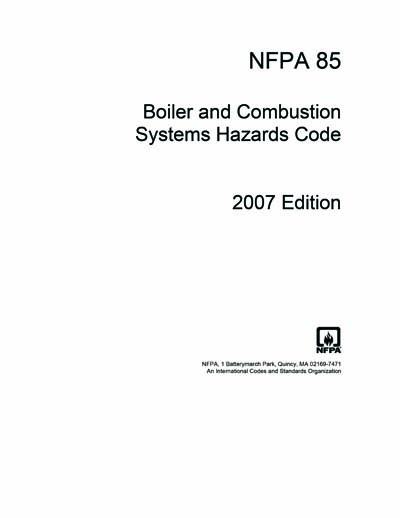Historical
NFPA 85-2007
NFPA 85: Boiler and Combustion Systems Hazards Code, 2007 Edition
This code shall apply to single burner boilers, multiple burner boilers, stokers, and atmospheric fluidized-bed boilers with a fuel input rating of 3.7 MWt (12.5 million Btu/hr) or greater, to pulverized fuel systems, and to fired or unfired steam generators used to recover heat from combustion turbines [heat recovery steam generators (HRSGs)].
- 1.1.1 This code shall cover design, installation, operation, maintenance, and training.
- 1.1.2 This code shall cover strength of the structure, operation and maintenance procedures, combustion and draft control equipment, safety interlocks, alarms, trips, and other related controls that are essential to safe equipment operation.
- 1.1.3 Coordination of the design and operating procedures of the boiler furnace or HRSG system and any flue gas cleanup systems downstream of the postcombustion gas passes shall be required. Such coordination shall include requirements for ensuring a continuous flow path from the combustion air inlet through the stack.
- 1.1.4 Chapter 5, Single Burner Boilers, covers single burner boilers that fire the following fuels: (1) Natural gas as defined in 3.3.71.10. (2)* Other gas having a calorific value and characteristics similar to natural gas (3) Fuel oil of Grades 2, 4, 5, or 6 (4) Gas and oil that are fired simultaneously for fuel transfer (5) Gas and oil that are fired simultaneously and continuously.
- 1.1.5 Chapter 6, Multiple Burner Boilers, covers multiple burner boilers firing one or more of the following: (1) Gas fuel, as defined in 3.3.71.7 and 3.3.71.10 (2) Oil fuel, as defined in 3.3.71.3 (3) Pulverized coal fuel, as defined in 3.3.71.2.1 and simultaneous firing of more than one fuel.
- 1.1.6 Chapter 7, Atmospheric Fluidized-Bed Boilers, covers atmospheric fluidized-bed boilers.
- 1.1.7* Chapter 8, Heat Recovery Steam Generators, covers heat recovery steam generator (HRSG) systems.
- 1.1.8 Chapter 9, Pulverized Fuel Systems, covers pulverized fuel systems, beginning with the raw fuel bunker, which is upstream of the pulverizer and the point at which primary air enters the pulverizing system, and terminating at the point where pressure can be relieved by fuel being burned or collected in a device that is built in accordance with this code. The pulverized fuel system shall include the primary air ducts, which are upstream of the pulverizer, to a point where pressure can be relieved.
- 1.1.9 Chapter 10, Stokers, covers boilers using a stoker to fire the following fuels: (1) Coal (2) Wood (3) Refuse-derived fuel (RDF) (4) Municipal solid waste (MSW) (5) Other solid fuels.
- 1.1.9.1 Where solid fuel is fired simultaneously with other fuels (e.g., a solid fuel stoker fired in combination with gas, oil, or pulverized auxiliary fuel), additional controls and interlocks shall include those covered in Chapters 5, 6, and 9. Exception No. 1: The purge requirements of Chapters 5 and 6 shall not be required when the stoker is firing and the boiler is on-line. In those cases, if no cooling air is being provided to the auxiliary burners, a purge of their associated air supply ducts shall be provided. Exception No. 2: Where oil or gas is fired in a supervised manual system in accordance with Chapter 5, the excessive steam pressure interlock shall not be required.
National Fire Protection Association [nfpa]

